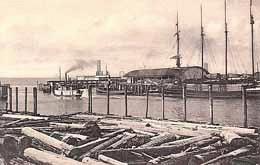On June 29, 1915, U.S. Customs officials at Grays Harbor seize the schooner
Annie Larsen
, which is found to be carrying arms and ammunition in violation of neutrality laws. This is the end of an ill-fated attempt by Irish and German operatives to foment violence in India against British authorities during World War I. The man in charge of the mission is one Walter Page of Kansas City, whose true identity is L. Othmer, a sea captain whose ship had already been interned by U.S. authorities. Othmer, alias Page, will escape federal custody and disappear. The government will sell the arms and ammunition to pay fines and liens against the ship.
With World War I raging in Europe, German Hans Tauscher purchased a load of surplus U.S. Army arms and ammunition dating from the 1860s and 1870s. Tauscher was arrested for violation of U.S. neutrality laws, but the shipment was loaded aboard the three-masted, 326-ton schooner Annie Larsen at San Diego in February 1915. The Annie Larsen was under charter to a Los Angeles ship broker, who assigned one Walter Page as supercargo. Page was really Captain L. Othmer of the German bark Atlas, which had been interned by the U.S. Government in San Francisco. Page had complete authority over the movements of the ship and he ordered Captain Plaul Schlueter (also spelled Schulter) to sail for Socorro Island in Mexico.
Page's plan was to rendezvous with the steamer Maverick and transfer 4,500 old rifles, several cases of revolvers, and 4,750,000 rounds of ammunition. The Maverick was to deliver the munitions to German agents in India. But the British Secret Service had learned of the plot and the Royal Navy cruiser H.M.S. Newcastle shadowed the old steamer and the Maverick's master backed out of the scheme.
When the Annie Larsen ran out of food and water, she sailed to Acapulco, but Captain Schlueter and Page ran into another war, the Mexican Revolution, and their lies got them into trouble. They tried to clear Acapulco, held by the Carranza forces, for Topolobambo, held by the forces of Pancho Villa. The Carranza forces were not about to let munitions go to their enemies and the schooner was seized. Only through the intervention by U.S. Navy officers from the cruiser U.S.S. Yorktown, also at Acapulco at the time, was the Annie Larsen released. The schooner returned to Socorro Island to wait for the Maverick. When water and provisions ran short again, Captain Schlueter elected to find a U.S. port north of San Francisco. Almost five months after leaving San Diego, the Annie Larsen arrived at Hoquiam.
Deputy Collector of Customs R. L. Sebastian found the munitions and seized the cargo as contraband as well as the ship, believing they were bound for the war in Mexico. The crew was placed under arrest. That night, Page, dressed in underwear and socks, got permission from a guard to go forward. He slipped overboard to an awaiting rowboat and made it ashore where an automobile waited to help him make his escape.
The government condemned the shipment and sold it at auction to the surplus dealer who had sold it to the Germans the first time. The proceeds paid a $500 fine and the freight bills run up by the chartering broker. Captain Schlueter loaded a cargo of lumber for San Diego.

